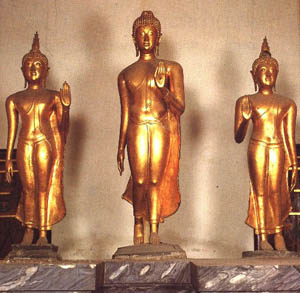Wat Bowonniwet Vihara
Wat Bowonniwet Vihara is a Royal Buddhist monastery of the Dhammayut tradition,
located on the northeast side of Bangkok’s Ratanakosin island, just inside the
ancient wall bordering Banglumpoo canal, on Pra Sumeru road. The monastery’s
name comes from the Pali language, Pavara+niwesa, and translates as Temple of
the Excellent Abode.
 Wat
Bowonniwet Vihara, or Wat Bowon for short, has a long and dazzling history
beginning with the arrival of the first abbot, H.R.H. Prince Mongkut, in 1836.
The prince bhikkhu, also known by his ordained name, Vajiranyana, was ordained
for twenty-seven years and abbot of this monastery for fourteen before he left
the Order, on the death of his brother, the third king, and ascended the throne
as King Rama IV. There have been six abbots from the beginning to the present,
three of whom have been Supreme Patriarchs. The former abbots after King
Mongkut were: Somdet Pra Maha Samana Chao Krom Phraya Pavares Variyalongkorn,
the second abbot from 1851 - 1892; H.H. Somdet Pra Maha Samana Chao Krom Phraya
Vajiranyanavarorassa, the third abbot from 1892 - 1921; H.H. Somdet Pra
Sangharaj Chao Krom Luang Vajiranyanavongse, the fourth abbot from 1921 - 1958;
Ven. Pra Prommuni, the fifth abbot from 1958 - 1961; and H.H. Somdet Pra
Nyanasamvara, the sixth and present abbot from 1961 - Wat
Bowonniwet Vihara, or Wat Bowon for short, has a long and dazzling history
beginning with the arrival of the first abbot, H.R.H. Prince Mongkut, in 1836.
The prince bhikkhu, also known by his ordained name, Vajiranyana, was ordained
for twenty-seven years and abbot of this monastery for fourteen before he left
the Order, on the death of his brother, the third king, and ascended the throne
as King Rama IV. There have been six abbots from the beginning to the present,
three of whom have been Supreme Patriarchs. The former abbots after King
Mongkut were: Somdet Pra Maha Samana Chao Krom Phraya Pavares Variyalongkorn,
the second abbot from 1851 - 1892; H.H. Somdet Pra Maha Samana Chao Krom Phraya
Vajiranyanavarorassa, the third abbot from 1892 - 1921; H.H. Somdet Pra
Sangharaj Chao Krom Luang Vajiranyanavongse, the fourth abbot from 1921 - 1958;
Ven. Pra Prommuni, the fifth abbot from 1958 - 1961; and H.H. Somdet Pra
Nyanasamvara, the sixth and present abbot from 1961 -
Before the arrival of Venerable Vajiranyana, the land presently occupied by Wat
Bowonniwet was actually two different monasteries separated by a canal -- Wat
Mai to the west and Wat Rangsee Suddhawas to the east. As Wat Mai was
abbot-less at the time, H.M. the third king requested the prince bhikkhu to
assume the position. Later, during the reign of the sixth king, the two
monasteries were incorporated into one resulting in the temple’s present
dimensions.
|
|
|
|